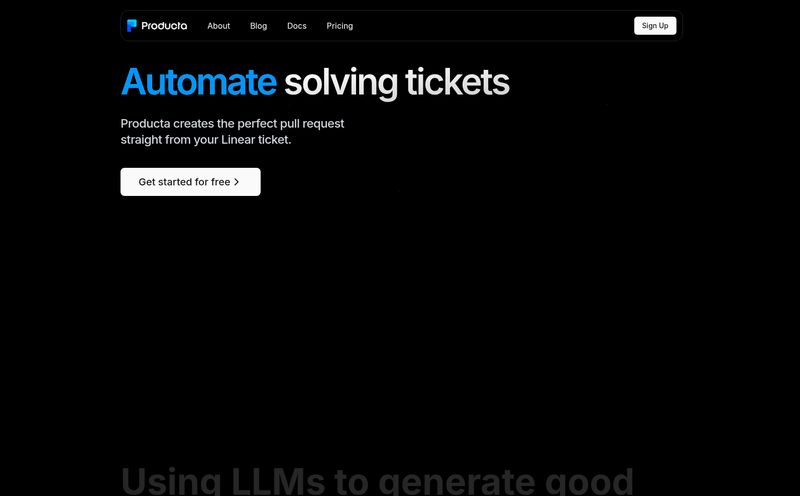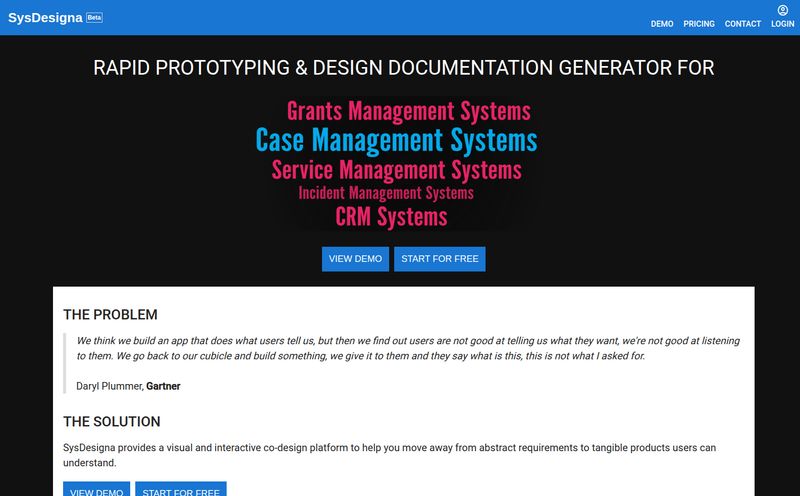For the past couple of years, my inbox and social feeds have been absolutely drowning in "game-changing AI tools." Every other startup promises to revolutionize my workflow, make me 10x more productive, and probably also do my laundry. And honestly? Most of them are just fancy wrappers around a GPT API. A little prompt engineering, a slick UI, and boom, you've got a business.
So when I first heard about Bellaire, I was skeptical. The promise wasn't just another chatbot. It was about building intelligent AI agents. Agents that can think, collaborate with each other, and automate complex workflows. My inner nerd was intrigued, but my inner seasoned-and-slightly-jaded SEO guy rolled his eyes.
But I gave it a shot. And... I'm glad I did. This one feels different. It's less of a simple tool and more of a whole new workshop for building your own digital workforce. So, grab a coffee, and let's get into whether Bellaire is just more AI hype or the real deal.
So What Exactly Is Bellaire, Anyway?
At its heart, Bellaire is a platform designed to let you build and deploy AI agents without needing a PhD in computer science. Think of it less like a single tool and more like a command center. Instead of just having one AI that answers questions, you can build a whole team of them. A specialized agent for customer support, another for lead qualification, and a third for data analysis. And the coolest part? They can work together.

Visit Bellaire
It’s built on what they call a multi-agent architecture. This is a concept that’s been floating around in high-level AI research for a while, but Bellaire is one of the first platforms I've seen that actually makes it accessible to a business user. It’s like instead of hiring one generalist who's okay at everything, you hire a team of specialists who are brilliant at their one thing and know exactly when to pass the baton to a teammate. That’s the core idea here: moving from simple task automation to intelligent process orchestration.
The Core Features That Actually Matter
Okay, let's cut through the marketing fluff. I've been poking around the platform, and here are the bits that really stood out to me as a professional who lives and breathes this stuff.
The AI Agent Builder is Your No-Code Command Center
This is the main event. The builder is surprisingly intuitive. You can define an agent's role, give it access to specific tools (like your CRM or a database), and set its objectives. It’s more than just a glorified chatbot builder; you’re setting up a system that can make decisions. I remember trying to stitch together a workflow with three different apps back in 2019, and it was a nightmare of webhooks and prayers. This feels like the grown-up solution to that problem.
Finally, Workflow Automation That Thinks
We've all used tools like Zapier or Make. They are great for simple “if this, then that” logic. But what happens when the logic needs to be more nuanced? That's where Bellaire's workflow automation comes in. Because the agents are powered by Large Language Models (LLMs), they can handle ambiguity. For example, you can create a workflow where an agent reads an incoming email, understands its intent (is it a complaint, a sales inquiry, or spam?), and then routes it to the correct human or another AI agent. That’s a huge leap forward from just matching keywords.
Bring Your Own Brain (or a Dozen of Them)
This is a big one for me. Bellaire supports over 25 different LLMs. You are NOT locked into the OpenAI ecosystem. Want to use Claude 3 for its creative writing? Go for it. Prefer Google's Gemini for its analytical power? No problem. This flexibility is critical. It means you can pick the right "brain" for the right job and you're not at the mercy of one company's pricing or policy changes. It's a level of future-proofing that I wish more platforms offered.
Let's Talk Money: The Bellaire Pricing Breakdown
Alright, this all sounds powerful and expensive, right? Well, let's break it down. Their pricing model is usage-based, which I'm a fan of. It's built around two main things: AI Tokens and Workflow Runs.
- AI Tokens: Think of these as the fuel for your AI agents' brains. Every time an agent processes information—like summarizing a document or having a conversation—it uses tokens.
- Workflow Runs: This is counted each time an automated workflow is triggered from start to finish.
Here’s a quick look at their plans:
| Plan | Price | Key Features |
|---|---|---|
| Starter | $99/mo | 1.25M AI Tokens, 100 Workflow Runs, 1 Team Seat |
| Pro | $499/mo | 6.25M AI Tokens, 1000 Workflow Runs, 5 Team Seats |
| Enterprise | Inquire | Unlimited everything, private hosting, SAML SSO, dedicated support |
But here is the absolute kicker: They offer a 90-day, full-access free trial. Ninety days! That's not a typo. In a world of 7-day or 14-day trials, three months is an eternity. It shows a massive amount of confidence in their product. It gives you more than enough time to actually build something meaningful and see a real return before you have to spend a dime.
My Honest Take: The Good and The Not-So-Good
No tool is perfect. Let's get into the nitty-gritty. What I love, and what makes me pause.
What I Really Like About Bellaire
The biggest pro is the sheer ambition and potential. This isn't just another incremental improvement; it feels like a step in a new direction for business automation. The flexibility of using different LLMs is a huge, huge win. And for businesses concerned with data privacy, the Enterprise option for private hosting and bringing your own keys (BYOK) is exactly what the market needs. It’s a powerful platform for anyone who wants to automate complex processes, not just simple tasks.
Where It Could Improve
Now, for the reality check. For my enterprise-level clients, the fact that ISO 27001 and SOC 2 certifications are still pending is a yellow flag. It's a critical checkbox for any company handling sensitive data, and while I'm sure it's on their roadmap, it's not there yet. Also, some of the best features, like private LLM servers, are gated behind the top-tier Enterprise plan. That's pretty standard for SaaS, but it's a bit of a bummer for a scaling startup that might want that level of privacy but isn't quite at teh enterprise level yet.
Finally, let's be real. While it's marketed as a low-code platform, I'd call it "low-code, high-logic." To really harness the power of multi-agent workflows, you need to think like a systems designer. There's a learning curve. It's not a magic button, but what powerful tool is?
Who is This Platform Actually For?
After playing around with it, I see a few key profiles who would get a ton of value out of Bellaire:
- Innovative Operations Managers: The people who are currently held together by a tangled web of Zapier zaps and custom scripts. This could be their central command.
- Growth-Focused SMBs: Small to medium-sized businesses that want to implement sophisticated automation to compete with larger players but lack a dedicated team of AI developers.
- Enterprise Teams: Specifically, departments within large organizations that need to build secure, custom internal tools for things like HR onboarding, internal support, or financial analysis without a multi-million dollar development project.
Final Thoughts: Is Bellaire the Future?
Look, I'm not going to tell you that Bellaire will solve all your problems overnight. But it's one of the most interesting and forward-thinking platforms I've seen in the automation space in a long time. It successfully moves the conversation from "Can we connect this app to that app?" to "Can we design an intelligent system to manage this entire process?"
It's ambitious, powerful, and yes, it has a bit of a learning curve. But it feels like a genuine step towards the promise of AI we've been hearing about for so long. And with a ridiculously generous 90-day free trial, there's literally no risk in taking it for a spin. If you're serious about workflow automation and getting ahead of the curve, you owe it to yourself to see what building a real AI agent feels like.
Frequently Asked Questions
- What is an AI agent in Bellaire?
- An AI agent is a specialized AI program you build on the platform. You give it a role (e.g., "Sales Development Rep"), access to tools (like your CRM, email, etc.), and an objective. It can then act autonomously to achieve that objective, even collaborating with other agents.
- Do I need to be a programmer to use Bellaire?
- No, you don't need to be a programmer. The platform is low-code and uses a visual interface. However, you will need a good understanding of logic and workflows to design effective multi-agent systems.
- What kind of integrations does Bellaire support?
- It supports integration with hundreds of applications, including common CRMs, marketing platforms, databases, and communication tools. The goal is to let your agents access the same tools your human team uses.
- How does the 90-day free trial work?
- The 90-day free trial gives you full access to the platform's features, including a generous amount of AI tokens and workflow runs, so you can build, test, and validate your AI agents before committing to a paid plan.
- Is Bellaire secure for sensitive business data?
- Bellaire offers several data privacy options. For maximum security, the Enterprise plan includes options for private hosting and BYOK (Bring Your Own Keys), ensuring your data remains within your control. However, their main security certifications like ISO 27001 are still pending, which is a consideration for highly regulated industries.
- What's the difference between AI Tokens and Workflow Runs?
- AI Tokens are consumed when an AI agent processes language (thinking, summarizing, chatting). A Workflow Run is a single execution of an automated process from start to end. You need both to power your automations, but they measure different aspects of the system's usage.
Reference and Sources
- Bellaire Official Website
- Ben's Bites - For general trends on AI agents and automation.



